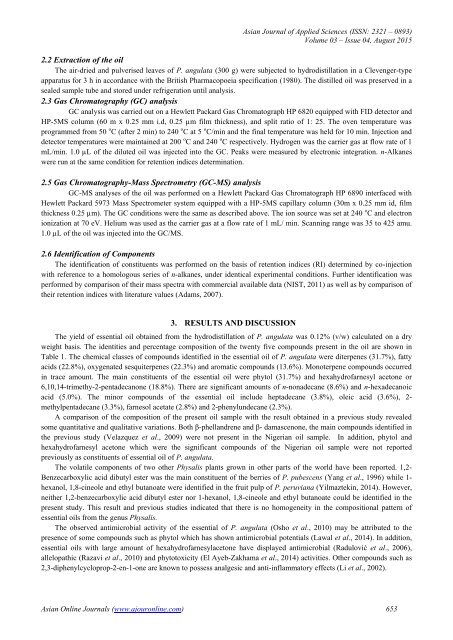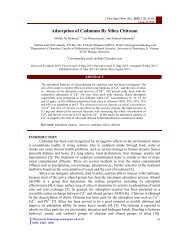Chemical Constituents of the Leaf Essential Oil of Physalis angulata L.
Create successful ePaper yourself
Turn your PDF publications into a flip-book with our unique Google optimized e-Paper software.
Asian Journal <strong>of</strong> Applied Sciences (ISSN: 2321 – 0893)<br />
Volume 03 – Issue 04, August 2015<br />
2.2 Extraction <strong>of</strong> <strong>the</strong> oil<br />
The air-dried and pulverised leaves <strong>of</strong> P. <strong>angulata</strong> (300 g) were subjected to hydrodistillation in a Clevenger-type<br />
apparatus for 3 h in accordance with <strong>the</strong> British Pharmacopoeia specification (1980). The distilled oil was preserved in a<br />
sealed sample tube and stored under refrigeration until analysis.<br />
2.3 Gas Chromatography (GC) analysis<br />
GC analysis was carried out on a Hewlett Packard Gas Chromatograph HP 6820 equipped with FID detector and<br />
HP-5MS column (60 m x 0.25 mm i.d, 0.25 µm film thickness), and split ratio <strong>of</strong> 1: 25. The oven temperature was<br />
programmed from 50 o C (after 2 min) to 240 o C at 5 o C/min and <strong>the</strong> final temperature was held for 10 min. Injection and<br />
detector temperatures were maintained at 200 o C and 240 o C respectively. Hydrogen was <strong>the</strong> carrier gas at flow rate <strong>of</strong> 1<br />
mL/min. 1.0 µL <strong>of</strong> <strong>the</strong> diluted oil was injected into <strong>the</strong> GC. Peaks were measured by electronic integration. n-Alkanes<br />
were run at <strong>the</strong> same condition for retention indices determination.<br />
2.5 Gas Chromatography-Mass Spectrometry (GC-MS) analysis<br />
GC-MS analyses <strong>of</strong> <strong>the</strong> oil was performed on a Hewlett Packard Gas Chromatograph HP 6890 interfaced with<br />
Hewlett Packard 5973 Mass Spectrometer system equipped with a HP-5MS capillary column (30m x 0.25 mm id, film<br />
thickness 0.25 µm). The GC conditions were <strong>the</strong> same as described above. The ion source was set at 240 o C and electron<br />
ionization at 70 eV. Helium was used as <strong>the</strong> carrier gas at a flow rate <strong>of</strong> 1 mL/ min. Scanning range was 35 to 425 amu.<br />
1.0 µL <strong>of</strong> <strong>the</strong> oil was injected into <strong>the</strong> GC/MS.<br />
2.6 Identification <strong>of</strong> Components<br />
The identification <strong>of</strong> constituents was performed on <strong>the</strong> basis <strong>of</strong> retention indices (RI) determined by co-injection<br />
with reference to a homologous series <strong>of</strong> n-alkanes, under identical experimental conditions. Fur<strong>the</strong>r identification was<br />
performed by comparison <strong>of</strong> <strong>the</strong>ir mass spectra with commercial available data (NIST, 2011) as well as by comparison <strong>of</strong><br />
<strong>the</strong>ir retention indices with literature values (Adams, 2007).<br />
3. RESULTS AND DISCUSSION<br />
The yield <strong>of</strong> essential oil obtained from <strong>the</strong> hydrodistillation <strong>of</strong> P. <strong>angulata</strong> was 0.12% (v/w) calculated on a dry<br />
weight basis. The identities and percentage composition <strong>of</strong> <strong>the</strong> twenty five compounds present in <strong>the</strong> oil are shown in<br />
Table 1. The chemical classes <strong>of</strong> compounds identified in <strong>the</strong> essential oil <strong>of</strong> P. <strong>angulata</strong> were diterpenes (31.7%), fatty<br />
acids (22.8%), oxygenated sesquiterpenes (22.3%) and aromatic compounds (13.6%). Monoterpene compounds occurred<br />
in trace amount. The main constituents <strong>of</strong> <strong>the</strong> essential oil were phytol (31.7%) and hexahydr<strong>of</strong>arnesyl acetone or<br />
6,10,14-trimethy-2-pentadecanone (18.8%). There are significant amounts <strong>of</strong> n-nonadecane (8.6%) and n-hexadecanoic<br />
acid (5.0%). The minor compounds <strong>of</strong> <strong>the</strong> essential oil include heptadecane (3.8%), oleic acid (3.6%), 2-<br />
methylpentadecane (3.3%), farnesol acetate (2.8%) and 2-phenylundecane (2.3%).<br />
A comparison <strong>of</strong> <strong>the</strong> composition <strong>of</strong> <strong>the</strong> present oil sample with <strong>the</strong> result obtained in a previous study revealed<br />
some quantitative and qualitative variations. Both β-phellandrene and β- damascenone, <strong>the</strong> main compounds identified in<br />
<strong>the</strong> previous study (Velazquez et al., 2009) were not present in <strong>the</strong> Nigerian oil sample. In addition, phytol and<br />
hexahydr<strong>of</strong>arnesyl acetone which were <strong>the</strong> significant compounds <strong>of</strong> <strong>the</strong> Nigerian oil sample were not reported<br />
previously as constituents <strong>of</strong> essential oil <strong>of</strong> P. <strong>angulata</strong>.<br />
The volatile components <strong>of</strong> two o<strong>the</strong>r <strong>Physalis</strong> plants grown in o<strong>the</strong>r parts <strong>of</strong> <strong>the</strong> world have been reported. 1,2-<br />
Benzecarboxylic acid dibutyl ester was <strong>the</strong> main constituent <strong>of</strong> <strong>the</strong> berries <strong>of</strong> P. pubescens (Yang et al., 1996) while 1-<br />
hexanol, 1,8-cineole and ethyl butanoate were identified in <strong>the</strong> fruit pulp <strong>of</strong> P. peruviana (Yilmaztekin, 2014). However,<br />
nei<strong>the</strong>r 1,2-benzecarboxylic acid dibutyl ester nor 1-hexanol, 1,8-cineole and ethyl butanoate could be identified in <strong>the</strong><br />
present study. This result and previous studies indicated that <strong>the</strong>re is no homogeneity in <strong>the</strong> compositional pattern <strong>of</strong><br />
essential oils from <strong>the</strong> genus <strong>Physalis</strong>.<br />
The observed antimicrobial activity <strong>of</strong> <strong>the</strong> essential <strong>of</strong> P. <strong>angulata</strong> (Osho et al., 2010) may be attributed to <strong>the</strong><br />
presence <strong>of</strong> some compounds such as phytol which has shown antimicrobial potentials (Lawal et al., 2014). In addition,<br />
essential oils with large amount <strong>of</strong> hexahydr<strong>of</strong>arnesylacetone have displayed antimicrobial (Radulović et al., 2006),<br />
allelopathic (Razavi et al., 2010) and phytotoxicity (El Ayeb-Zakhama et al., 2014) activities. O<strong>the</strong>r compounds such as<br />
2,3-diphenylcycloprop-2-en-1-one are known to possess analgesic and anti-inflammatory effects (Li et al., 2002).<br />
Asian Online Journals (www.ajouronline.com) 653




